Alberta
Suspect in stolen vehicle kills one and seriously injures another in wild chase

News release from Beaumont RCMP
Beaumont RCMP seeking public assistance in locating suspect in fatal collision
On Feb. 24, 2024, at approximately 9:00 p.m., Beaumont RCMP located a person suspected of theft, in a parked 15-foot cube moving truck, at a business on 50 Street in Beaumont. When members approached the truck and attempted an arrest, one male driver and one female passenger rammed into a police vehicle and fled the scene at a high rate of speed. Patrols were initiated to find the truck and, a short time later, it was observed on 50 Street and Highway 814 in Beaumont at a high rate of speed.
Meanwhile, Edmonton Police Service’s (EPS) Air One Helicopter was notified and provided its location to RCMP members. Multiple surrounding RCMP detachments, including Leduc and Strathcona, responded to assist. As the truck was driving into Edmonton, a tire deflation device was deployed by RCMP, disabling multiple civilian vehicles. Consequently, an adult female exited one of the civilian vehicles and was fatally struck by the suspect truck. The truck failed to stop and continued driving into Edmonton.
The suspect vehicle then collided with another civilian vehicle, leaving an adult male in serious non-life-threatening condition. The truck was located at 50 Street and 22 Avenue in Southwest Edmonton.
Further investigation revealed that the driver of the truck, an adult male, then proceeded to steal a parked 2020 Honda Civic at a nearby convenience store. This vehicle contained a child who was safely recovered and reunited with his family a short time later. The male suspect has yet to be located.
No other members of the public or officers were injured during this incident.
“On behalf of the RCMP, I would like to send our heartfelt condolences to the family members of the victim,” said Superintendent Leanne MacMillian, Assistant Central Alberta District Officer. “This is a devastating incident that will leave a mark on family and friends for years to come. Please understand that you will be in our thoughts as we progress through this investigation.”
In compliance with legislative requirements, the Director of Law Enforcement was immediately notified causing the deployment of ASIRT to conduct an independent investigation. The RCMP believes in accountability and transparency and in so doing will provide full support to the ASIRT investigators and also conduct its own internal review. Events like this are difficult for the communities in which they occur, as well as the general public and RCMP officers involved. RCMP officers recognize the trust placed in them to use force that is necessary, proportional and reasonable and in so doing remain fully accountable.
The RCMP are actively investigating this occurrence and are seeking the public’s assistance in locating a stolen, dark grey 4-door Honda Civic with Alberta license place E98-099. The vehicle was stolen by a male suspect described as being approximately 5’11’’ and was last seen wearing a black hoodie with white text on the front, brown shorts and black shoes.
If you have any information about this crime or those responsible, you are asked to contact the Beaumont RCMP at 780-929-7400. If you wish to remain anonymous you can contact Crime Stoppers by phone at 1‐800‐222‐8477 (TIPS), by Internet at www.tipsubmit.com or by SMS (check your local Crime Stoppers www.crimestoppers.ab.ca for instructions).
Alberta
Red Deer Justice Centre Grand Opening: Building access to justice for Albertans

The new Red Deer Justice Centre will help Albertans resolve their legal matters faster.
Albertans deserve to have access to a fair, accessible and transparent justice system. Modernizing Alberta’s courthouse infrastructure will help make sure Alberta’s justice system runs efficiently and meets the needs of the province’s growing population.
Alberta’s government has invested $191 million to build the new Red Deer Justice Centre, increasing the number of courtrooms from eight to 12, allowing more cases to be heard at one time.
“Modern, accessible courthouses and streamlined services not only strengthen our justice
system – they build safer, stronger communities across the province. Investing in the new Red Deer Justice Centre is vital to helping our justice system operate more efficiently, and will give people in Red Deer and across central Alberta better access to justice.”

Government of Alberta and Judiciary representatives with special guests at the Red Deer Justice Centre plaque unveiling event April 22, 2025.
On March 3, all court services in Red Deer began operating out of the new justice centre. The new justice centre has 12 courtrooms fully built and equipped with video-conference equipment to allow witnesses to attend remotely if they cannot travel, and vulnerable witnesses to testify from outside the courtroom.
The new justice centre also has spaces for people taking alternative approaches to the traditional courtroom trial process, with the three new suites for judicial dispute resolution services, a specific suite for other dispute resolution services, such as family mediation and civil mediation, and a new Indigenous courtroom with dedicated venting for smudging purposes.
“We are very excited about this new courthouse for central Alberta. Investing in the places where people seek justice shows respect for the rights of all Albertans. The Red Deer Justice Centre fills a significant infrastructure need for this rapidly growing part of the province. It is also an important symbol of the rule of law, meaning that none of us are above the law, and there is an independent judiciary to decide disputes. This is essential for a healthy functioning democracy.”
“Public safety and access to justice go hand in hand. With this investment in the new Red Deer Justice Centre, Alberta’s government is ensuring that communities are safer, legal matters are resolved more efficiently and all Albertans get the support they need.”
“This state-of-the-art facility will serve the people of Red Deer and surrounding communities for generations. Our team at Infrastructure is incredibly proud of the work done to plan, design and build this project. I want to thank everyone, at all levels, who helped make this project a reality.”
Budget 2025 is meeting the challenge faced by Alberta with continued investments in education and health, lower taxes for families and a focus on the economy.

Quick facts
- The new Red Deer Justice Centre is 312,000 sq ft (29,000 m2). (The old courthouse is 98,780 sq ft (9,177 m2)).
- The approved project funding for the Red Deer Justice Centre is about $191 million.
Alberta
Made in Alberta! Province makes it easier to support local products with Buy Local program

Show your Alberta side. Buy Local. |
When the going gets tough, Albertans stick together. That’s why Alberta’s government is launching a new campaign to benefit hard-working Albertans.
Global uncertainty is threatening the livelihoods of hard-working Alberta farmers, ranchers, processors and their families. The ‘Buy Local’ campaign, recently launched by Alberta’s government, encourages consumers to eat, drink and buy local to show our unified support for the province’s agriculture and food industry.
The government’s ‘Buy Local’ campaign encourages consumers to buy products from Alberta’s hard-working farmers, ranchers and food processors that produce safe, nutritious food for Albertans, Canadians and the world.
“It’s time to let these hard-working Albertans know we have their back. Now, more than ever, we need to shop local and buy made-in-Alberta products. The next time you are grocery shopping or go out for dinner or a drink with your friends or family, support local to demonstrate your Alberta pride. We are pleased tariffs don’t impact the ag industry right now and will keep advocating for our ag industry.”
Alberta’s government supports consumer choice. We are providing tools to help folks easily identify Alberta- and Canadian-made foods and products. Choosing local products keeps Albertans’ hard-earned dollars in our province. Whether it is farm-fresh vegetables, potatoes, honey, craft beer, frozen food or our world-renowned beef, Alberta has an abundance of fresh foods produced right on our doorstep.
Quick facts
- This summer, Albertans can support local at more than 150 farmers’ markets across the province and meet the folks who make, bake and grow our food.
- In March 2023, the Alberta government launched the ‘Made in Alberta’ voluntary food and beverage labelling program to support local agriculture and food sectors.
- Through direct connections with processors, the program has created the momentum to continue expanding consumer awareness about the ‘Made in Alberta’ label to help shoppers quickly identify foods and beverages produced in our province.
- Made in Alberta product catalogue website
Related information
-

 Business1 day ago
Business1 day agoTrump: China’s tariffs to “come down substantially” after negotiations with Xi
-

 2025 Federal Election2 days ago
2025 Federal Election2 days agoMark Carney Wants You to Forget He Clearly Opposes the Development and Export of Canada’s Natural Resources
-

 Business1 day ago
Business1 day agoTrump considers $5K bonus for moms to increase birthrate
-

 Business2 days ago
Business2 days agoHudson’s Bay Bid Raises Red Flags Over Foreign Influence
-

 2025 Federal Election2 days ago
2025 Federal Election2 days agoCanada’s pipeline builders ready to get to work
-

 Business24 hours ago
Business24 hours agoChinese firm unveils palm-based biometric ID payments, sparking fresh privacy concerns
-

 2025 Federal Election1 day ago
2025 Federal Election1 day agoPolice Associations Endorse Conservatives. Poilievre Will Shut Down Tent Cities
-

 2025 Federal Election1 day ago
2025 Federal Election1 day agoCanada’s press tries to turn the gender debate into a non-issue, pretend it’s not happening




